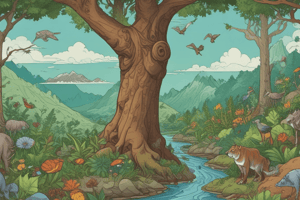Podcast
Questions and Answers
Which organisms harness energy from sunlight to convert water, carbon dioxide, and nutrients into chemical energy?
Which organisms harness energy from sunlight to convert water, carbon dioxide, and nutrients into chemical energy?
- Producers (correct)
- Decomposers
- Herbivores
- Carnivores
What role do carnivores play in the food chain?
What role do carnivores play in the food chain?
- They break down dead organisms.
- They consume other consumers. (correct)
- They convert sunlight into energy.
- They feed directly on plants and algae.
What is the primary function of decomposers in an ecosystem?
What is the primary function of decomposers in an ecosystem?
- To convert sunlight into energy
- To break down dead organisms and waste (correct)
- To feed directly on plants and algae
- To store energy for consumption by consumers
Which of the following is an example of a consumer in the food chain?
Which of the following is an example of a consumer in the food chain?
What role do herbivores play in ecosystems?
What role do herbivores play in ecosystems?
What is the role of fungi and bacteria in the food chain?
What is the role of fungi and bacteria in the food chain?
Which organisms feed on the decomposers in the food chain?
Which organisms feed on the decomposers in the food chain?
What is the primary role of producers in the food chain?
What is the primary role of producers in the food chain?
Why are decomposers essential in maintaining ecosystem balance?
Why are decomposers essential in maintaining ecosystem balance?
How do consumers contribute to the food chain?
How do consumers contribute to the food chain?
Flashcards
Producers
Producers
Organisms that create their own food from sunlight, water, and carbon dioxide via photosynthesis.
Consumers
Consumers
Organisms that obtain energy by feeding on other organisms (producers or other consumers). Classified as herbivores, carnivores, or omnivores.
Decomposers
Decomposers
Organisms that break down dead organic material, releasing nutrients back into the environment.
Herbivore
Herbivore
Signup and view all the flashcards
Carnivore
Carnivore
Signup and view all the flashcards
Omnivore
Omnivore
Signup and view all the flashcards
Trophic Level
Trophic Level
Signup and view all the flashcards
Food Chain
Food Chain
Signup and view all the flashcards
Food Web
Food Web
Signup and view all the flashcards
Photosynthesis
Photosynthesis
Signup and view all the flashcards
Study Notes
Unraveling the Food Chain: Producers, Consumers, and Decomposers
In our world teeming with life, the intricate dance of the food chain is a fundamental process that drives ecosystems. To understand how energy and nutrients flow through the web of life, let's delve into the roles of the producers, consumers, and decomposers.
Producers
Plants and algae are the primary producers. They harness energy from sunlight through photosynthesis to convert water, carbon dioxide, and nutrients from the soil into chemical energy stored in the form of sugars and starches. This energy is then passed on to other organisms.
For example, a wheat field is a thriving community of producers, such as the wheat grasses that photosynthesize and store energy for consumption by herbivores like deer and rabbits.
Consumers
Herbivores, carnivores, and omnivores are consumers. They obtain their energy and nutrients by feeding on producers and other consumers. Each level of the food chain is referred to as a trophic level.
Herbivores, like cows and rabbits, feed directly on plants and algae. Carnivores, such as lions and wolves, eat herbivores. Omnivores, like humans and bears, consume both plants and animals.
Decomposers
Decomposers are not typically consumed but play a critical role in the food chain. They break down dead organisms and waste, releasing nutrients back into the environment. Fungi, bacteria, and detritivores are all decomposers.
For instance, consider a fallen leaf in a forest. Decomposers like fungi and bacteria break it down, releasing nutrients that can be absorbed by the nearby plants. Insects, such as ants, also play a role by feeding on the decomposers, further recycling the nutrients.
The Circle of Life
The food chain is a cycle of energy and nutrient exchange, with each component playing its part. Producers create energy through photosynthesis, consumers feed on producers and each other, and decomposers break down waste. The food chain is complex and dynamic, with predators, prey, and mutualistic relationships continually evolving to adapt to environmental conditions.
The Interconnectedness of Life
The food chain is interconnected and is characterized by the flow of energy and nutrients. As producers, herbivores, and decomposers interact, they form intricate relationships that ultimately sustain life on Earth.
Understanding the food chain can help us appreciate the complexity of ecosystems and the delicate balance that keeps them stable. When one part of the food chain is disrupted, such as by overhunting or habitat destruction, the implications can be widespread and far-reaching.
So, the next time you walk through a forest, or even think of the food you're eating, remember the intricate food chain that supports all life on Earth.
Studying That Suits You
Use AI to generate personalized quizzes and flashcards to suit your learning preferences.




